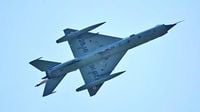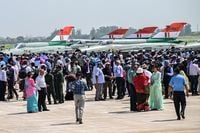On September 26, 2025, a resounding chapter in India’s military aviation history drew to a close. The Indian Air Force (IAF) officially retired its last fleet of Soviet-era MiG-21 fighter jets, ending more than six decades of service with an aircraft that once symbolized the country’s aerial might but later became infamous for its safety record. The event, held at the northern Indian air base of Chandigarh, was marked by a ceremonial last sortie led by Air Force Chief Air Marshal AP Singh, witnessed by Defense Minister Rajnath Singh. Upon landing, the aircraft was given a water cannon salute—a fitting tribute to a plane that has defined generations of Indian fighter pilots.
The MiG-21’s journey with India began in the early 1960s, when the IAF inducted the needle-nosed jet to bolster its air capabilities. According to the Associated Press, India procured 872 MiG aircraft of various models between 1966 and 1980, making it the largest operator of the type outside the Soviet Union. Over the years, nearly 900 MiG-21s, spanning multiple variants, were operated by India—a testament to the aircraft’s central role in the country’s defense strategy.
But numbers alone don’t tell the full story. The MiG-21, starting with the basic F-13 interceptor in 1963, evolved through local production and upgrades. The MiG-21FL (Type 77), with over 200 units built by Hindustan Aeronautics Limited (HAL), marked India’s first significant step into licensed aerospace manufacturing. Later variants, such as the MiG-21M, MiG-21MF, and Bis, brought improved high-altitude performance and more sophisticated avionics and weapon systems. The crowning achievement was the Bison upgrade program of the 2000s, which transformed 125 aircraft with Israeli radars, modern avionics, and beyond-visual-range missile capability—extending their operational life by decades, as highlighted by Mathrubhumi.
Technically, the MiG-21 was a marvel for its time. Its Tumansky R-25 engine, installed in later variants, produced over 7,000 kilograms of thrust, propelling the jet to speeds exceeding 2,500 kilometers per hour—more than twice the speed of sound. The aircraft’s compact 7-meter wingspan and delta-wing design made it agile, capable of pulling 8.5G in combat and climbing at up to 235 meters per second. Its armament ranged from 23mm cannons to advanced R-77 missiles on the Bison, with a fully loaded weight of around 10,400 kilograms. The MiG-21’s 1,600-kilometer combat radius and quick 30-minute turnaround between sorties gave the IAF operational flexibility during crises.
The MiG-21’s combat record is as storied as its technical specs. In the 1965 war with Pakistan, MiG-21s scored their first kills, downing Pakistani Sabres and helping establish air superiority. During the 1971 Bangladesh Liberation War, the jets not only shot down F-86s and F-104 Starfighters but also carried out ground attacks, including the bombing of the Governor’s house in Dhaka—a mission that played a crucial role in forcing Pakistani surrender in East Pakistan. The 1999 Kargil conflict saw MiG-21s providing air cover and ground support in challenging high-altitude conditions. Most recently, in the February 2019 Balakot crisis, a MiG-21 Bison piloted by Wing Commander Abhinandan Varthaman shot down a Pakistani F-16, proving that, with skilled pilots and smart upgrades, even older platforms could hold their own against more modern adversaries.
However, the MiG-21’s legacy isn’t without its shadows. Frequent crashes—482 reported between 1971 and April 2012, resulting in the deaths of 171 pilots, 39 civilians, 8 service personnel, and 1 aircrew member—earned the aircraft the grim nickname “flying coffin.” Human error and technical issues were cited as primary causes, and these incidents inspired cultural touchstones such as the Bollywood film “Rang De Basanti.” The crash data has not been updated since, but the reputation lingered, fueling calls for modernization and greater safety in India’s air fleet.
Despite its challenges, the MiG-21 was a formative influence for generations of Indian pilots. As Group Captain Indranil Nandi told the Associated Press, “The MiG-21 has the distinction of being an aircraft which has trained generations of Indian fighter pilots. It was a joy to fly. It made me the fighter pilot I am today.”
The retirement of the MiG-21 underscores an urgent reality for the Indian Air Force. With the jet’s departure, the IAF is left with 29 fighter squadrons—each comprising 16 to 18 aircraft—well short of the 42 squadrons once endorsed by the government. This capability gap is especially concerning given the advanced air fleets of neighboring China and Pakistan. Defense analyst N.C. Bipindra warned, “If the drop in India’s fighter fleet is not arrested quickly, it will make it challenging to counter neighboring adversaries that have advanced jets for modern day warfare.”
India is now banking on a rapid transition to indigenous and modern platforms. The state-run HAL has contracts to supply 87 Tejas light-combat jets, though deliveries have been delayed due to shortages of U.S.-imported engines. On September 25, 2025, the Defense Ministry signed a new contract for an additional 97 Tejas, with deliveries expected to begin in 2027. The IAF also operates French-made Rafales, Mirage 2000s, Russian Su-30s, and MiG-29s, but the focus is shifting toward building domestic capabilities. There’s consideration of locally manufacturing Rafales in partnership with France’s Dassault Aviation, and while the United States has expressed interest in supplying F-35 stealth fighters, New Delhi has so far prioritized homegrown solutions.
Looking back, the MiG-21’s greatest legacy may be the technical and institutional knowledge it fostered. India produced nearly 600 MiG-21s under license at HAL, gaining invaluable experience in jet engine manufacturing, avionics, and weapons integration. The evolution from the basic F-13 to the sophisticated Bison variant reflects India’s growing confidence and capability in aerospace technology. As Mathrubhumi noted, “This wasn’t just modification—it was systems integration at a level that few air forces worldwide could manage.”
For the Indian public, the MiG-21 was more than just a machine; it was a symbol of national aspiration and resilience. Its operational record, both triumphant and tragic, mirrors the broader story of India’s rise as a regional power. The transition to the Tejas Mk-1A and future indigenous aircraft now represents not just modernization, but a declaration of technological independence—a commitment to build, maintain, and improve upon sophisticated military platforms on Indian soil.
As India bids farewell to the MiG-21, the moment is both a celebration of past achievements and a call to action for the future. The “sky warrior’s” ultimate gift may not be its combat record or service longevity, but the confidence it instilled in a nation now poised to reach even higher in the aerospace domain.

